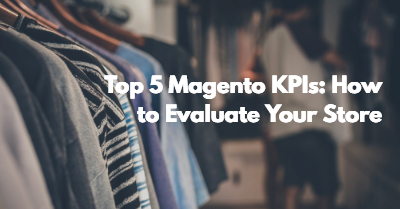Top 5 Magento KPIs: How to Evaluate Your Store
When a business owner invests their money and resources in an e-commerce company, it makes sense to pause and ask “Is what I am doing is really working?”. Retailers have to continuously evaluate their Magento-driven businesses to identify the most profitable products, find out which channel converts the best and get to know who their customers are.
With such a plethora of indicators provided by Google Analytics, it is easy to get lost in eCommerce benchmarks and overlook the most important ones. As far as some metrics are less valuable than others, identifying KPIs (key performance indicators) should be one of the prior tasks for entrepreneurs.
To make your job easier, we made up a list of the core business KPIs that can help you get comprehensive reports on how your Magento-driven website is doing.
KPI #1. Conversion Rate
Conversion rate is one of the most strategic benchmarks as it is closely interrelated with overall revenue metrics. Low conversion is an indicator that a store can’t convince visitors to buy products or take some other desired actions (it depend on what action is treated as conversion). This means that there is a screw loose somewhere: in your content, UX, or customer journey.
The metric is calculated by dividing the total number of visitors by the total number of conversions (in general, when it comes to e-commerce businesses, the number of customers that complete purchase after visiting a site is regarded as conversions).
Let’s assume that your website got 1000 visitors in a month, of which 20 bought something from your store. Thus, your conversion rate would be 2%.
Of course, you will fail to find an e-commerce website with a 100% conversion rate on the Internet. But what number can be considered as good? It greatly depends on the type of your business, what products you sell, and who your customers are. The average e-commerce conversions are 1-2%.
KPI#2. Cost of Customer Acquisition
Tracking this metric will give you an idea of how much much it costs to get a paying customer. To calculate CAC, divide the cost of your marketing efforts by the total number of customers acquired.
Here is the formula:
САС = TМСС ÷ TСА
, where TMCC is total marketing campaign costs, and TCA is the total number of customers acquired.
Let’s assume that you use Google AdWords to advertise your e-commerce store. When it is time to evaluate the effectiveness of your campaign, you get the following metrics:
- Cost per Click – $1,5
- Total number of clicks – 700
- Conversions – 20.
Thus, these numbers mean that you acquire 1 customer in every 35 clicks (700÷20=35). As far as one click cost is $1,5, it means that the CAC, in this case, is $52,5.
This hybrid metric is used to determine the effectiveness of your media campaigns. The higher the number, the more expensive it is for your business to acquire customers. That is why it makes sense to measure CAC separately for every marketing channel (discounts, email marketing, webinars, giveaways) to get a clear picture of your campaigns and decide whether it is worth it to continue to spend your budget on a particular channel.
KPI #3. Cart Abandonment Rate
When it comes to online retail, this KPI is essential for understanding a conversational process and eliminating guesswork. It shows the percentage of customers that add a product to the cart but doesn’t complete the checkout process for some reason.
Say, if 40 out of every 100 customers that add an item to the shopping cart abandon it afterward, you will get an abandonment rate of 40%. That fact should raise a red flag since you are losing your leads at the final stage of the sales pipeline. The first thing you need to do to reduce the number is to determine the reason they are leaving your store in order to reduce the frictions.
Among these factors may be:
- unexpected shipping cost
- the necessity to create a new user account to make an order
- payment security concerns
- frustrating checkout
- the inability to find the desired coupon code.
KPI#4. Customer Lifetime Value
CLV is closely tied to customer retention rate. It shows your customers’ loyalty and satisfaction, as well as gives you insights on how valuable every customer to you. As far as many e-commerce business owners now turn their viewers toward long-term relationships rather than one-time purchasing, placing a relentless focus on this KPI is a must.
To calculate Customer Lifetime Value, you need to find out how much the average customer pays you until they stop buying from you. There are a lot ways to measure this benchmark, the most common formula is:
Let’s assume that you own an online store with an average order value of $30. Using your CRM data, you identified that the average customer buys two times per year while having a lifespan of 4 years. In this case, your CLV would be $240.
Keep in mind that the lower your CLV is, the higher the chances that your shoppers will never come back after the first purchase. Savvy entrepreneurs create brand loyalty and build a long-term relationship with clients to improve CLV along with customer retention rates.
KPI#5. Bounce Rate
When visitors land to a website page, spend some time researching the content and leave it without opening the other pages, this activity is registered as a bounce. This means that there is a gap between what the visitors expected and what they have seen on the page.
Thus, the standard formula for calculating the bounce rate is:
According to the latest research, the average e-commerce website should expect this metric between 20-40%. The higher number indicates significant issues with a website that demand to be heeded ASAP. High bounce rate along with low dwell time are red flags for Google to degrade your website in search results as far as this means that it doesn’t correspond to users’ queries.
High bounce rate can be caused by various factors:
- UX problems
- non-friendly design
- navigation delay
- slow page load times
- poor marketing targeting
- unavailing content
- your website is not responsive
- web design issues.
However, if your bounce rate is too high, you need to carry out complex research to identify which aspect of your website has a blind spot. It is hard to do it alone without the help of experienced professionals who are currently working with your CMS. Besides, some complex CMSs for e-commerce websites such as Magento 2 require strong coding skills to optimize and customize a store. That is why we recommend consulting a Magento support agency to resolve the issue and gain more leads.


